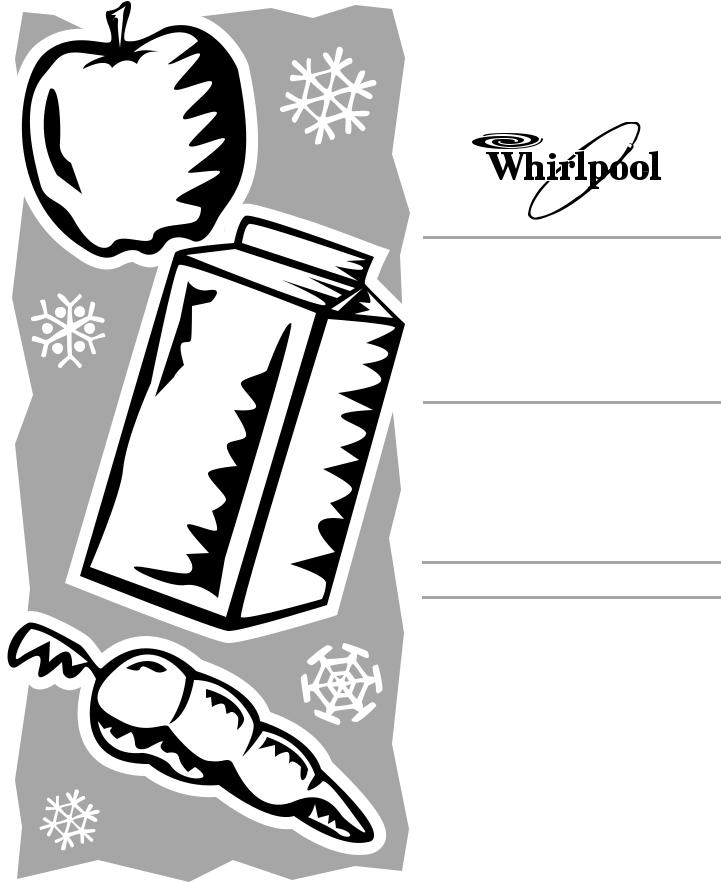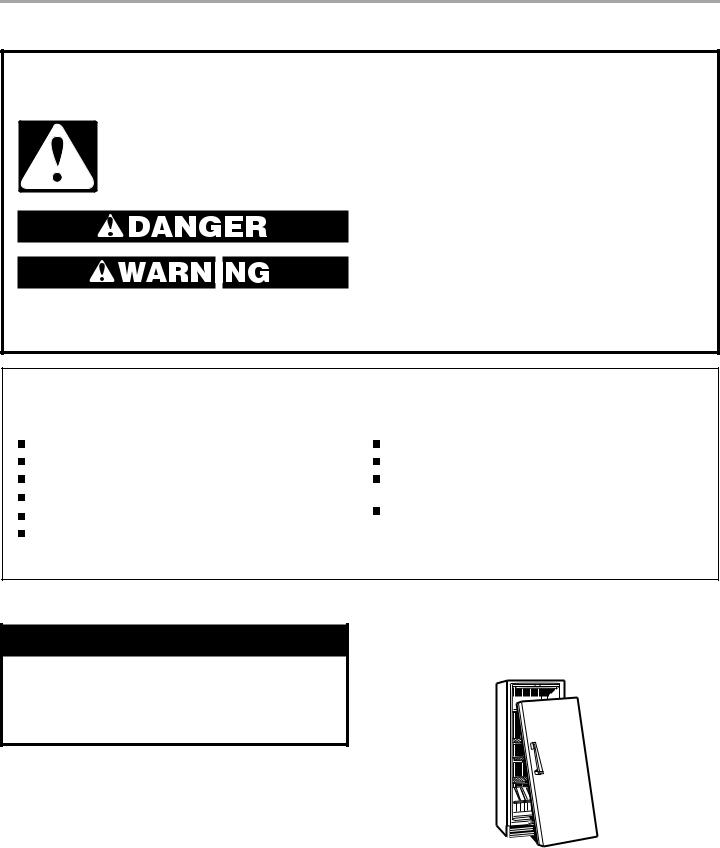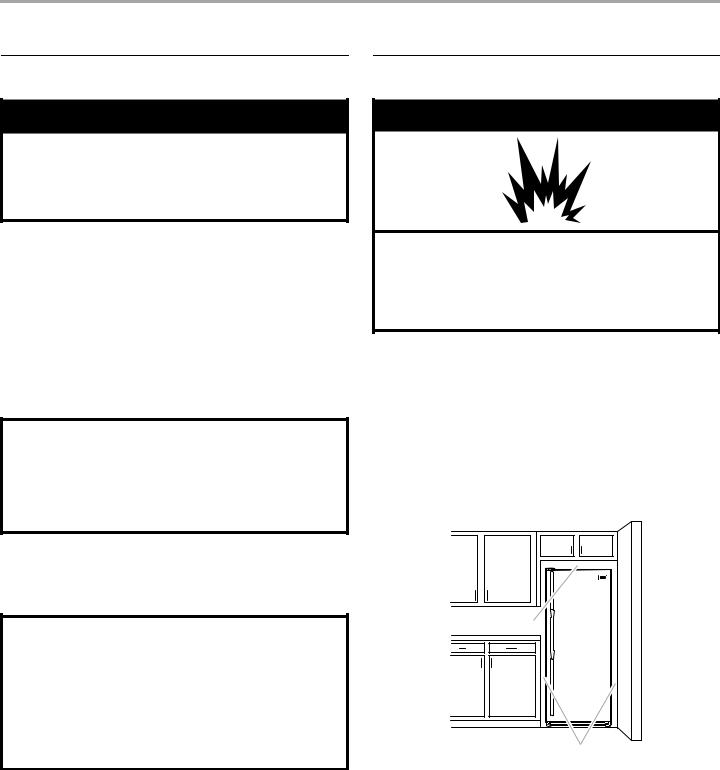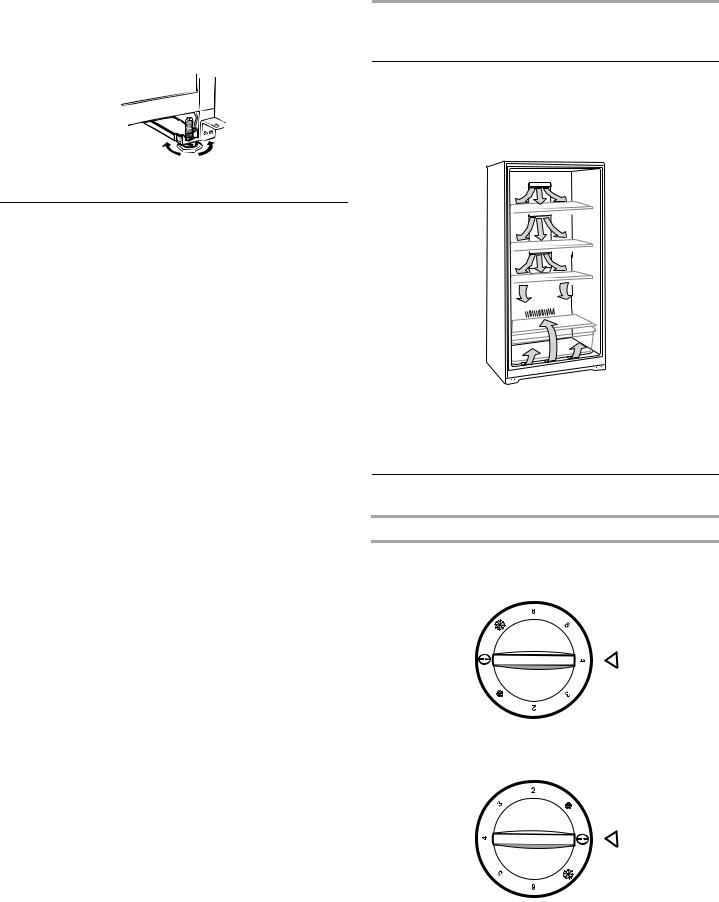Whirlpool EL7ATRRMS05, EL7ATRRMS00, EL7ATRRMS08, EL7ATRRMS07, EL7ATRRMS04 Owner’s Manual
...
®
REFRIGERATOR
Use & Care Guide
For questions about features, operation/performance parts, accessories or service, call: 1-800-253-1301.
In Canada, call for assistance 1-800-461-5681, for installation and service, call: 1-800-807-6777
or visit our website at...
www.whirlpool.com or www.whirlpool.com/canada
RÉFRIGÉRATEUR
Guide d’utilisation et d’entretien
Au Canada, pour assistance, composez le 1-800-461-5681, pour installation ou service, le 1-800-807-6777
ou visitez notre site web à www.whirlpool.com/canada
Table of Contents/Table des matières .................. |
2 |
2-60444-001/2300266

TABLE OF CONTENTS |
|
REFRIGERATOR SAFETY ............................................................. |
3 |
Proper Disposal of Your Old Refrigerator.................................... |
3 |
INSTALLATION INSTRUCTIONS .................................................. |
4 |
Unpacking .................................................................................... |
4 |
Location Requirements................................................................ |
4 |
Electrical Requirements ............................................................... |
5 |
Door Handle Installation and Removal ........................................ |
5 |
Door Closing................................................................................. |
5 |
Normal Sounds ............................................................................ |
6 |
REFRIGERATOR USE.................................................................... |
6 |
Ensuring Proper Air Circulation.................................................... |
6 |
Using the Control ......................................................................... |
6 |
REFRIGERATOR FEATURES ........................................................ |
7 |
Refrigerator Shelves..................................................................... |
7 |
Crispers and Meat Drawer........................................................... |
7 |
Crisper Humidity Control ............................................................. |
8 |
REFRIGERATOR CARE ................................................................. |
8 |
Cleaning........................................................................................ |
8 |
Changing the Light Bulb .............................................................. |
9 |
Vacation and Moving Care........................................................... |
9 |
TROUBLESHOOTING .................................................................... |
9 |
ASSISTANCE OR SERVICE......................................................... |
11 |
In the U.S.A. ............................................................................... |
11 |
In Canada ................................................................................... |
11 |
Accessories ................................................................................ |
11 |
WARRANTY .................................................................................. |
12 |
TABLE DES MATIÈRES |
|
SÉCURITÉ DU RÉFRIGÉRATEUR .............................................. |
14 |
Mise au rebut de votre vieux réfrigérateur................................. |
14 |
INSTRUCTIONS D’INSTALLATION............................................. |
15 |
Déballage.................................................................................... |
15 |
Emplacement d’installation........................................................ |
15 |
Spécifications électriques .......................................................... |
16 |
Installation et dépose des poignées de portes.......................... |
16 |
Fermeture de la porte................................................................. |
16 |
Sons normaux ............................................................................ |
17 |
UTILISATION DU RÉFRIGÉRATEUR.......................................... |
17 |
Pour s’assurer d’une circulation d’air appropriée...................... |
17 |
Utilisation de la commande........................................................ |
17 |
CARACTÉRISTIQUES DU RÉFRIGÉRATEUR ........................... |
18 |
Tablettes du réfrigérateur........................................................... |
18 |
Bacs à légumes et tiroirs à viande ............................................. |
18 |
Réglage de l’humidité dans le bac à légumes........................... |
19 |
ENTRETIEN DU RÉFRIGÉRATEUR ............................................ |
19 |
Nettoyage ................................................................................... |
19 |
Remplacement de l'ampoule d’éclairage .................................. |
20 |
Entretien avant les vacances ou lors d’un déménagement....... |
20 |
DÉPANNAGE................................................................................. |
21 |
ASSISTANCE OU SERVICE......................................................... |
22 |
Accessoires ................................................................................ |
22 |
GARANTIE..................................................................................... |
23 |
®
2

REFRIGERATORSAFETY
Your safety and the safety of others are very important.
We have provided many important safety messages in this manual and on your appliance. Always read and obey all safety messages.
This is the safety alert symbol.
This symbol alerts you to potential hazards that can kill or hurt you and others.
All safety messages will follow the safety alert symbol and either the word “DANGER” or “WARNING.” These words mean:
You can be killed or seriously injured if you don't immediately follow instructions.
You can be killed or seriously injured if you don't follow instructions.
All safety messages will tell you what the potential hazard is, tell you how to reduce the chance of injury, and tell you what can happen if the instructions are not followed.
IMPORTANT SAFETY INSTRUCTIONS
WARNING: To reduce the risk of fire, precautions:
Plug into a grounded 3 prong outlet. Do not remove ground prong.
Do not use an adapter.
Do not use an extension cord. Disconnect power before servicing. Replace all panels before operating.
electric shock, or injury when using your refrigerator, follow these basic
Remove doors from your old refrigerator. Use nonflammable cleaner.
Keep flammable materials and vapors, such as gasoline, away from refrigerator.
Use two or more people to move and install refrigerator.
SAVE THESE INSTRUCTIONS
Proper Disposal of Your Old Refrigerator
 WARNING
WARNING
Suffocation Hazard
Remove doors from your old refrigerator.
Failure to do so can result in death or brain damage.
IMPORTANT: Child entrapment and suffocation are not problems of the past. Junked or abandoned refrigerators are still dangerous
– even if they will sit for “just a few days.” If you are getting rid of your old refrigerator, please follow these instructions to help prevent accidents.
Before you throw away your old refrigerator or freezer:
■Take off the doors.
■Leave the shelves in place so that children may not easily climb inside.
3

INSTALLATION INSTRUCTIONS
Unpacking
 WARNING
WARNING
Excessive Weight Hazard
Use two or more people to move and install refrigerator.
Failure to do so can result in back or other injury.
Removing packaging materials
■Remove tape and glue residue from surfaces before turning on the refrigerator. Rub a small amount of liquid dish soap over the adhesive with your fingers. Wipe with warm water and dry.
■Do not use sharp instruments, rubbing alcohol, flammable fluids, or abrasive cleaners to remove tape or glue. These products can damage the surface of your refrigerator. For more information, see the “Refrigerator Safety” section.
■Depending on your model, remove protective film from shelf trims. Look for the “Peel Off” strip, and use your fingernail to peel off the film.
When Moving Your Refrigerator:
Your refrigerator is heavy. When moving the refrigerator for cleaning or service, be sure to protect the floor. Always pull the refrigerator straight out when moving it.
Do not wiggle or “walk” the refrigerator when trying to move it, as floor damage could occur.
Cleaning before use
After you remove all of the package materials, clean the inside of your refrigerator before using it. See the cleaning instructions in the “Refrigerator Care” section.
Important information to know about glass shelves and covers:
Do not clean glass shelves or covers with warm water when they are cold. Shelves and covers may break if exposed to sudden temperature changes or impact, such as bumping. For your protection, tempered glass is designed to shatter into many small, pebble-size pieces. This is normal. Glass shelves and covers are heavy. Use special care when removing them to avoid impact from dropping.
Location Requirements
 WARNING
WARNING
Explosion Hazard
Keep flammable materials and vapors, such as gasoline, away from refrigerator.
Failure to do so can result in death, explosion, or fire.
IMPORTANT: Do not install the refrigerator near an oven, radiator, or other heat source, nor in a location where the temperature will fall below 40°F (5°C)
Allow at least 3 in. (7.5 cm) of air space at the top and on both sides of the refrigerator and 1 in. (2.5 cm) between the back of the refrigerator and the wall. If the refrigerator is to be against a wall, leave extra space on the hinge side so the door can open wider.
NOTE: This refrigerator may be installed side by side with another refrigerator or freezer. Allow for a 3 in. (7.5 cm) clearance at the top and sides and a ¹⁄ in. (0.64 cm) clearance between the appliances.
3" (7.5 cm) |
3" (7.5 cm) |
4

Electrical Requirements
 WARNING
WARNING
Electrical Shock Hazard
Plug into a grounded 3 prong outlet.
Do not remove ground prong.
Do not use an adapter.
Do not use an extension cord.
Failure to follow these instructions can result in death, fire, or electrical shock.
Before you move your refrigerator into its final location, it is important to make sure you have the proper electrical connection.
Recommended grounding method
A 115 Volt, 60 Hz., AC only 15 or 20 ampere fused, grounded electrical supply is required. It is recommended that a separate circuit serving only your refrigerator be provided. Use an outlet that cannot be turned off by a switch. Do not use an
extension cord.
NOTE: Before performing any type of installation, cleaning, or removing a light bulb, turn the Temperature Control to the off position as shown and then disconnect the refrigerator from the electrical source.
When you are finished, reconnect the refrigerator to the electrical source and reset the Temperature Control to the desired setting.
Door Handle Installation and Removal
Tools Needed: Flat-blade screwdriver
1
2 
 3
3 
2 
1
1.Handle trim
2.Handle screws
3.Door handle
1.Place the handle on the door as shown.
2.Using a flat-blade screwdriver, attach the handle to the door with the 4 handle screws (provided).
3.Place the trim pieces on the upper and lower handle ends as shown.
NOTE: Some models have an (optional) gold trim piece that snaps on the handle ends before placing the end trim pieces.
4.Apply firm pressure with your hand on the face of the trim. Slide the top trim down and the bottom trim up toward the handle.
5.To remove the handle, reverse these directions.
Door Closing
NOTE: Keep the 2 bolts that secured the refrigerator in the shipping case. They are the front leveling legs.
Your refrigerator has 2 adjustable leveling legs. If your refrigerator seems unsteady or you want the doors to close easier, adjust the refrigerator's tilt using these instructions.
1.Screw the legs all the way into the bolt holes in the bottom corners of the refrigerator.
2.Plug into a grounded 3 prong outlet.
3.Move the refrigerator into its final position.
4.Adjust the front legs just enough to lift the cabinet up off of the floor.
NOTE: If your model is equipped with rollers, the front legs should be lowered enough to lift the rollers off of the floor to ensure the refrigerator does not roll forward when the door is opened.
5

5.Adjust the legs to level the refrigerator:
■Turn the leveling leg to the right to lower that side of the refrigerator.
■Turn the leveling leg to the left to raise that side of the refrigerator.
6.Check with a level.
7.Open and close the door to make sure it swings properly.
Normal Sounds
Your new refrigerator may make sounds that your old one didn’t make. Because the sounds are new to you, you might be concerned about them. Most of the new sounds are normal. Hard surfaces, like the floor, walls, and cabinets, can make the sounds seem louder. The following describes the kinds of sounds and what may be making them.
■Your refrigerator is designed to run more efficiently to keep your food items at the desired temperatures and to minimize energy usage. The high efficiency compressor and fans may cause your refrigerator to run longer than your old one. You may also hear a pulsating or high-pitched sound from the compressor or fans adjusting to optimize performance.
■You may hear the evaporator fan motor circulating air through the refrigerator compartment. The fan speed may increase as you open the doors or add warm food.
■Rattling noises may come from the flow of refrigerant, the water line, or items stored on top of the refrigerator.
■Water dripping on the defrost heater during a defrost cycle may cause a sizzling sound.
■As each cycle ends, you may hear a gurgling sound due to the refrigerant flowing in your refrigerator.
■Contraction and expansion of the inside walls may cause a popping noise.
■You may hear air being forced over the condenser by the condenser fan.
■You may hear water running into the drain pan during the defrost cycle.
REFRIGERATOR USE
Ensuring Proper Air Circulation
In order to ensure proper temperature, you need to permit proper airflow in the refrigerator. As shown in the illustration, cool air enters through the refrigerator wall and moves down. The air then recirculates through the vent near the bottom.
Do not block any of these vents with food packages. If the vents are blocked, airflow will be prevented, and temperature and moisture problems may occur
IMPORTANT: To prevent odors and drying out of food, wrap or cover foods tightly.
Using the Control
Setting the Control
For your convenience, your refrigerator control is preset at the factory. When you first install your refrigerator, make sure that the control is still preset to the mid-setting as shown.
NOTE: To turn your refrigerator off, turn the refrigerator control to the setting shown. Your product will not cool when the refrigerator control is set to the off position.
6

Adjusting the Control
Give the refrigerator time to cool down completely before adding food. It is best to wait 24 hours before putting food into the refrigerator. The control is set correctly when milk or juice is as cold as you like. Move the dial one setting at a time and wait
24 hours between adjustments.
IMPORTANT: If you add food before the refrigerator has cooled completely, your food may spoil. Turning the Temperature Control to a colder (higher) than recommended setting will not cool the compartment any faster.
NOTE: During high humidity, moisture may form on the outside of the refrigerator. To prevent rust, dry the refrigerator’s exterior and reset the Temperature Control to a colder (higher) setting.
Power Interruptions
If the electricity in your house goes off, call the power company and ask how long it will be off.
If the power will be off less than 4 hours, keep the refrigerator door closed to help foods stay cold.
If the power will be off more than 4 hours, use up any perishables and find alternative cold storage.
REFRIGERATOR
FEATURES
Important information to know about glass shelves and covers:
Do not clean glass shelves or covers with warm water when they are cold. Shelves and covers may break if exposed to sudden temperature changes or impact, such as bumping. For your protection, tempered glass is designed to shatter into many small, pebble-size pieces. This is normal. Glass shelves and covers are heavy. Use special care when removing them to avoid impact from dropping.
Refrigerator Shelves
Store similar foods together and adjust the shelves to fit different heights. This reduces the time the refrigerator door is open and saves energy.
To remove and replace a shelf:
1.Remove the shelf by pulling it forward slightly to align the shelf stops with the openings in the refrigerator compartment liner. Lift straight up, and pull the shelf out the rest of the way.
2.Replace the shelf by lowering the shelf stops through the openings in the refrigerator compartment liner. Slide the shelf in the rest of the way.
Crispers and Meat Drawer
Drawers
To remove and replace a drawer:
1.Slide drawer straight out to the stop. Lift the front of the drawer and slide it out the rest of the way.
2.Replace a drawer by sliding it back in fully past the stop.
Crisper Cover
To remove the crisper(s) cover:
1.Remove crisper(s). Hold the glass insert firmly with one hand and press up in the center of the glass insert until it rises above the plastic frame. Carefully slide the glass insert forward to remove.
2.Lift the cover frame and remove it.
To replace crisper cover:
1.Fit the back of the cover frame into the supports on the side walls of the refrigerator. Lower the front of the cover frame into place.
2.Slide the rear of the glass insert into the cover frame and lower the front into place.
Adjustable Meat Drawer (on some models)
The meat drawer can be placed on either the right or left side of the refrigerator.
To move the meat drawer:
1.Remove the meat drawer and cover. See “Refrigerator Shelves” section.
NOTE: The meat drawer cover has one fixed support that runs down the center of the shelf. The outside support is the adjustable one.
2.Using a Phillips screwdriver, remove the adjustable support and move it to the other side of the meat drawer cover.
3.Place the meat drawer cover in the desired location and slide the meat drawer back into position.
Meat Storage Guide
Store most meat in original wrapping as long as it is airtight and moisture-proof. Rewrap if necessary. See the following chart for storage times. When storing meat longer than the times given, freeze the meat.
Fresh fish or shellfish......................... |
use same day as purchased |
|
Chicken, ground beef, variety meats (liver) |
...................... 1-2 days |
|
Cold cuts, steaks/roasts .................................................. |
|
3-5 days |
Cured meats................................................................... |
|
7-10 days |
Leftovers - Cover leftovers with plastic wrap, aluminum foil, or place in containers with tight fitting lids.
7

Crisper Humidity Control
(on somemodels)
You can adjust the amount of humidity in the moisture-sealed crisper using the settings between HIGH and LOW.
LOW (open) lets moist air out of the crisper for best storage of fruits and vegetables with skins.
■Fruit: Wash, let dry and store in refrigerator in plastic bag in crisper. Do not wash or hull berries until they are ready to use. Sort and keep berries in original container in crisper.
■Vegetables with skins: Place in plastic bag or plastic container and store in crisper.
HIGH (closed) keeps moist air in the crisper for best storage of fresh, leafy vegetables.
■Leafy vegetables: Wash in cold water, drain and trim or tear off bruised and discolored areas. Place in plastic bag or plastic container and store in crisper.
REFRIGERATOR CARE
Cleaning
Explosion Hazard
Use nonflammable cleaner.
Failure to do so can result in death, explosion, or fire.
Clean the refrigerator about once a month to prevent odors from building up. Wipe up spills immediately.
To clean your refrigerator:
1.Unplug refrigerator or disconnect power.
2.Remove all removable parts from inside, such as shelves, crispers, etc.
3.Hand wash, rinse, and dry removable parts and interior surfaces thoroughly. Use a clean sponge or soft cloth and a mild detergent in warm water.
■Do not use abrasive or harsh cleaners such as window sprays, scouring cleansers, flammable fluids, cleaning waxes, concentrated detergents, bleaches or cleansers containing petroleum products on plastic parts, interior and door liners or gaskets. Do not use paper towels, scouring pads, or other harsh cleaning tools. These can scratch or damage materials.
■To help remove odors, you can wash interior walls with a mixture of warm water and baking soda (2 tbs. to 1 qt. [26 g to 0.95 L] of water).
4.Replace the removable parts.
5.Use the appropriate cleaning method for your exterior finish.
Painted metal: Wash exteriors with a clean sponge or soft cloth and a mild detergent in warm water. Do not use abrasive or harsh cleaners, or cleaners designed for stainless steel. Dry thoroughly with a soft cloth. For additional protection against damage to painted metal exteriors, apply appliance wax (or auto paste wax) with a clean, soft cloth. Do not wax plastic parts.
Stainless steel finish: Wash with a clean sponge or soft cloth and a mild detergent in warm water. Do not use abrasive or harsh cleaners. Dry thoroughly with a soft cloth.
■To keep your stainless steel refrigerator looking like new and to remove minor scuffs or marks, it is suggested that you use the manufacturer’s approved Stainless Steel Cleaner & Polish.
IMPORTANT: This cleaner is for stainless steel parts only!
Do not allow the Stainless Steel Cleaner & Polish to come into contact with any plastic parts such as the trim pieces, dispenser covers or door gaskets. If accidental contact does occur, clean plastic part with a sponge and mild detergent in warm water. Dry thoroughly with a soft cloth. To order the cleaner, see the “Accessories” section.
6.Clean the condenser coils regularly. Coils may need to be cleaned as often as every other month. This may help save energy.
■Open the refrigerator door and remove the base grille by pulling down and out from the top.
■Remove the defrost pan and clean it using a clean sponge or soft cloth and a mild detergent in warm water. Hand wash, rinse, and dry it thoroughly.
■Use a vacuum with an extended attachment to clean the condenser coils when they are dusty or dirty.
■Replace the defrost pan.
■Replace the base grille by putting the clips in the openings in the refrigerator panel. Push in until the base grille snaps into place.
7.Plug in refrigerator or reconnect power.
8
